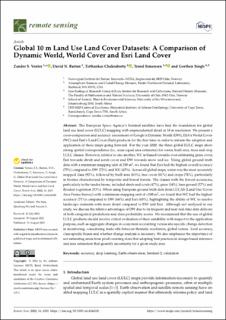Global 10 m Land Use Land Cover Datasets: A Comparison of Dynamic World, World Cover and Esri Land Cover
Peer reviewed, Journal article
Published version

Åpne
Permanent lenke
https://hdl.handle.net/11250/3054469Utgivelsesdato
2022Metadata
Vis full innførselSamlinger
- Publikasjoner fra CRIStin - NINA [2397]
- Scientific publications [1423]
Originalversjon
10.3390/rs14164101Sammendrag
The European Space Agency’s Sentinel satellites have laid the foundation for global land use land cover (LULC) mapping with unprecedented detail at 10 m resolution. We present a cross-comparison and accuracy assessment of Google’s Dynamic World (DW), ESA’s World Cover (WC) and Esri’s Land Cover (Esri) products for the first time in order to inform the adoption and application of these maps going forward. For the year 2020, the three global LULC maps show strong spatial correspondence (i.e., near-equal area estimates) for water, built area, trees and crop LULC classes. However, relative to one another, WC is biased towards over-estimating grass cover, Esri towards shrub and scrub cover and DW towards snow and ice. Using global ground truth data with a minimum mapping unit of 250 m2 , we found that Esri had the highest overall accuracy (75%) compared to DW (72%) and WC (65%). Across all global maps, water was the most accurately mapped class (92%), followed by built area (83%), tree cover (81%) and crops (78%), particularly in biomes characterized by temperate and boreal forests. The classes with the lowest accuracies, particularly in the tundra biome, included shrub and scrub (47%), grass (34%), bare ground (57%) and flooded vegetation (53%). When using European ground truth data from LUCAS (Land Use/Cover Area Frame Survey) with a minimum mapping unit of <100 m2 , we found that WC had the highest accuracy (71%) compared to DW (66%) and Esri (63%), highlighting the ability of WC to resolve landscape elements with more detail compared to DW and Esri. Although not analyzed in our study, we discuss the relative advantages of DW due to its frequent and near real-time data delivery of both categorical predictions and class probability scores. We recommend that the use of global LULC products should involve critical evaluation of their suitability with respect to the application purpose, such as aggregate changes in ecosystem accounting versus site-specific change detection in monitoring, considering trade-offs between thematic resolution, global versus. local accuracy, class-specific biases and whether change analysis is necessary. We also emphasize the importance of not estimating areas from pixel-counting alone but adopting best practices in design-based inference and area estimation that quantify uncertainty for a given study area. accuracy; deep learning; Earth observation; Sentinel-2; validation
